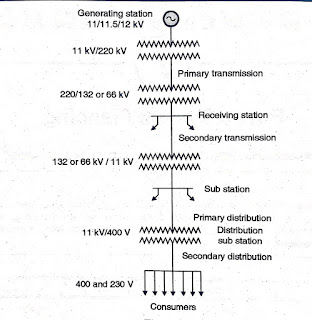Introduction To System Planning
Introduction To System Planning
Power system consists of generation system, transmission system and distribution system. Figure shows the power system network.
 |
| Single Line Diagram Of Power System |
Main aims of power system planning are :
- Reliable operation of power system.
- Safer operation of power system.
- Effective control of power flow through the power networks.
- To minimize the risk of component failure on reliability of power system.
- Economical development of society for enriching the life of humans.
- Development of planning standards.
- Industrial growth.
- Future generation and transmission plant planning.
- Analysis of existing network.
- Selection of optimization method. Here both nonlinear and linear methods are used.
- Nothing down outage record and its analysis and reasons.
- In analysis of existing network, following points are considered.
- Collection of historical data containing the parameter like peak demand, growth rate and future development.
- Automation development like use of SCADA, PLC, E-TAP softwares etc.
- Reliability assessment which depends on circuit length, customer density etc.
Criterion for deciding maximum permissible loading of transmission line. In short transmission line thermal limits i.e. temperature rise is taken into account. In medium transmission line, voltage drop is considered to be main affecting parameter while in long transmission line angle stability is the main factor of concerns for power system planner.
Operating performance standard related :
- Operating voltage level
- Rapid voltage change
- Harmonics present in the voltage and current.
- Load factor
- Diversity factor
- Reliability.
Review of system improvement where following factors are considered :
- Equipment performance
- Equipment loading
- Plant operating data
- Plant operational procedures
Power system planning is divided into three types :
- Generation system planning
- Transmission system planning
- Distribution system planning
- System load
- Market rules and regulations
- Government policies
- Bidding ability of generators
- Availability of generation system and transmission lines
- Carbon prices and environment cost
- Installations and replacement of transmission facilities.
Power system planning also classified by taking time reference are :
- Short term planning
- Medium term planning and
- Long term planning
Power system planning involves :
- Load forecasting
- Energy forecasting
- Power quality analysis.
- Power system planning involves :
- Load forecasting
- Energy forecasting
- Power quality analysis
- Providing right of ways
- Investment analysis and calculations
- Electricity demand variation analysis
- Development of rules and regulations for better operations of power system
- Use of newer technologies
- System monitoring involving use of SCADA's, remote terminal units (RTU's) etc.
- Electricity market price
- Fuel prices variations
- Political acceptance
- Generation and load balance
- Busbar voltage selection
- Fuel cost
- Voltage angle
- Minimum and maximum operating hours
- Entire cost
- Generation bids
- Minimum up and down time
- Spinning reserve
- Ramp rate limits of generation units
- Bi-lateral contracts
- Limits on capacitor adjustment
- Availability of water in case of hydro power plant
- Transmission power flow
- Unit commitment which is a non convex, nonlinear, larger scale, mixed integral optimization problem.























0 Comments